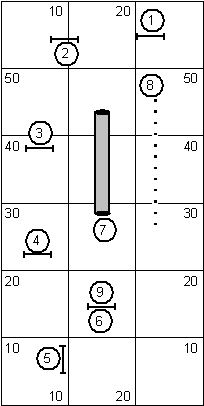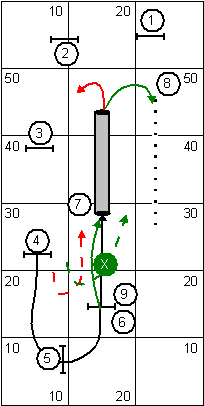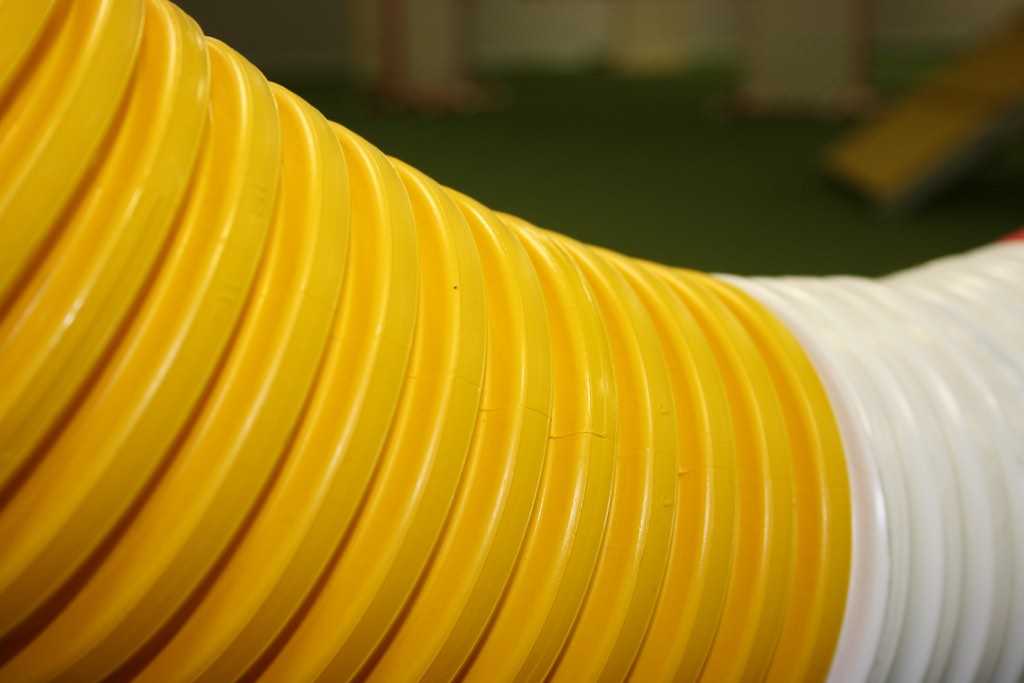Turning Dogs Out of Straight Tunnels
02 Nov 2005
A few weeks ago Dana Pike setup a course with a 15 foot straight tunnel followed by a 180 degree turn into the weaves. As handlers, we were concerned that we wouldn’t be in position to assist the dog with the turn to the weaves. Here’s a pretend course that illustrates the problem:

Regardless of how you might handle the sequence above, imagine that you can’t get to the exit of the tunnel in time to assist your dog to turn towards the weaves. For those who compete in Gamblers in USDAA or perform “distance challenges” in NADAC imagine a gamble line runs horizontally from the entrance to the tunnel to the exit of the weaves.
There are two, what I’ll call, “influences” that you can use to cue your dog to turn the correct direction in this situation:
- Handler Side Influence. Barring additional communication, the dog will look for the handler on the side that the handler was on as they entered the tunnel. i.e. the handler is on the dog's left on the way into the tunnel the dog will expect the handler will be on the dog's left when the dog exits the tunnel. The key point being "barring additional communication" (i.e. directional commands: "right"). I view this influence as a "Corollary" of one of Bud Houston's The Laws of Dogs in Motion: "A dog ahead of the handler tends to curl back to the handler's position".
- Lead Leg Influence. The dog will exit a tunnel on the same Lead Leg as they need to perform the tunnel. i.e. the dog enters a tunnel curved to the dog's left on a left lead, they will exit the tunnel on a left lead. If a dog enters a tunnel that turns in the opposite direction of the dog's lead when entering it will have to change leads in order to turn through the tunnel. i.e. the dog enters a tunnel curved to the dog's left on a right lead, they will exit the tunnel on a left lead - the dog must be on a left lead to turn left. But the key point in our example is that a dog entering a straight tunnel won't normally change lead leg before they come out of the tunnel.

Applying these influences to our example course, we want the dog to turn to their right coming out of the tunnel. Applying the Handler Side influence, if the handler is on the dog’s left as they approach the tunnel and if the handler does nothing else the dog is likely to turn left coming out of the tunnel (shown by the red paths in the diagram above). So it would be helpful to be on the dog’s right as it enters the tunnel.
Using the Lead Leg influence, approaching the tunnel from jump 6 the dog could be on either lead; they may be continuing on the left lead they used to turn from jump 5 to jump 6 or they may switch to a right lead if that is their physiological preference. I understand some dogs are “handed” just like people are and when given no other input will switch to their preferred lead. We want the dog to turn to their right coming out of the tunnel; if we ensure the dog is on a right lead going into the tunnel it will turn to the right coming out of the tunnel.
So by combining these influences we can perform a
Front Cross Learning the Front Cross - VideoFront Cross or Rear Cross Learning the Rear CrossRear Cross on the approach to the tunnel (shown by the green "X" in the diagram above). Either maneuver applies both influences (as long as the dog sees the cross). The Handler Side influence - because we will be changing or have changed to the dogs right side, the dog will look for the handler on their right as they come out of the tunnel; turning the dog to the right. The Lead Leg influence - because by executing the cross we've cued the dog to change to a right lead. To cue the lead change, as opposed to only a side change, the handler may need to slightly curve the dog's path to the right on the way into the tunnel (shown exaggerated in the green dog path above).When Dana pointed out the dog would turn to the right out of the tunnel if we put it onto a right lead entering the tunnel I understood it intellectually. But it was another thing to see it work so perfectly in practice. Two runs in a row Milo turned right into the weaves without my having to move past the tunnel entrance and without any other cues. I hadn’t thought to use a dog’s lead to my advantage in that way before; a great “WOW” moment.
If you enjoyed this article won't you please:  Thanks!
Thanks!
Related Articles:
- Turning Dogs out of a Curved Tunnel - Diane Carson's NC Regional Relay Course - With Video
- Putting a Cross In Only to Take it Back Out
- Rear Crossing to Setup The Dog's Line
- Dana Pike Weave Entry/Exit, Straight Tunnel Challenges
- Backyard Dogs Practice Sequences - 2018 May
- Birgitta Hermansson Tunnels/Jumps Practice Sequences - Video
